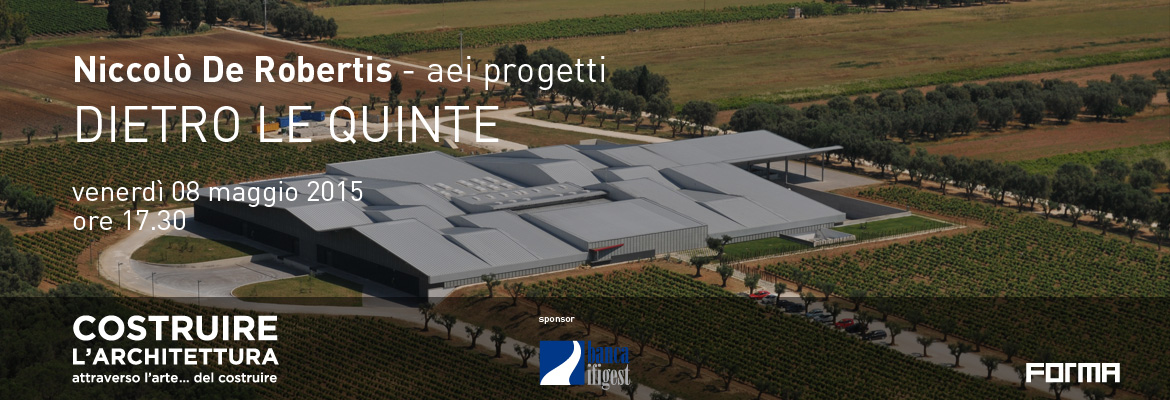Venerdì – 08 mag 2015 – ore 17.30
Costruire l’architettura: “Dietro le quinte”
Niccolò De Robertis – aei progetti
Dietro ogni progetto – per lo più si pensa – c’è la mente creativa dell’architetto, impegnata nella ricerca della configurazione spaziale, e poi quella calcolante dell’ingegnere, ingaggiata per applicare all’edificio già configurato le regole che ne fondano la concretezza statica.
Niccolò De Robertis ha mostrato con chiarezza quale sia il lavoro che, con lo studio di ingegneria aei progetti, compie “dietro le quinte”. Una realtà ben diversa dal luogo comune. Le quattro opere esposte sono firmate da studi di architettura, così come un film viene identificato dal nome del regista. Eppure, quelle stesse opere, De Robertis le sente sue creazioni e ne ha vissute progettazione e realizzazione al pari di tutti gli altri partecipanti.
Tra questi, non ultimo, il committente, non è solo colui che ci mette i soldi, così come l’ingegnere non è semplicemente il calcolatore che conosce e impone le regole dei numeri; ma spesso un visionario che sfida i limiti dell’esistente alla ricerca del loro superamento.
Il fatto è che si è abituati a pensare alla tecnica in modo riduttivo e inadeguato, posta in un ruolo puramente strumentale e subordinato. C’è il committente che finanzia e pone lo scopo d’uso dell’edificio. L’architetto immaginifico che ne crea la forma spaziale, conferendogli il suo valore simbolico ed estetico. L’ingegnere che deve farlo stare in piedi, imponendogli le dure leggi della necessità.
Ciò perché per lo più sfugge la logica del rapporto scopo/mezzo. Posto lo scopo, che è sempre ideologico in quanto è ciò che ancora non è se non come idea – sia esso l’uso, il piacere estetico, la statica – il mezzo per realizzarlo, ossia la tecnica con la quale si tenta di perseguirlo, è destinato esso a rovesciarsi in scopo. È necessario cioè perseguire la potenza tecnica (il come si realizza il voluto) senza la quale non c’è speranza di conquistare alcuno scopo.
Ne viene che l’atto del progettare coinvolge allo stesso titolo committente, architetto e ingegnere e consiste propriamente nel potenziamento dei mezzi di realizzazione dei rispettivi scopi. Potenziamento che è continua ricerca del superamento dei limiti contingenti. Quei limiti oltre i quali s’incontra il futuro e, una volta incontrato, occorre di nuovo superarlo. Sicché, l’attività progettante, ossia la ricerca del superamento dei limiti – lo si è visto con chiarezza negli esempi esposti – non termina se non con la realizzazione dell’opera, per poi riprendere in un’altra opera.
Francesco Ventura
Friday – may 08th 2015 – 17.30 pm
Building the architecture: “Behind the scenes”
Niccolò De Robertis – aei progetti
Behind every design — most think — there is the creative mind of an architect that devises the spatial configuration, and then the calculating mind of the engineer that applies rules to the already configured building that form its actual stability.
Niccolò De Robertis clearly showed us the work done “behind the scenes” with the Aei Progetti engineering firm. It is a very different world than the stereotypes would have it. The four projects shown bear the names of architecture firms, just as a film is identified with the director’s name. Yet, for De Robertis, those works are his creations too and he experienced their planning and construction on par with all the others involved.
Important among those people is the client, who does more than put up the money, just as the engineer is not just a calculator who knows and imposes the number rules, but is often a visionary challenging the limits what is already there to try to surpass them.
The fact is that we have grown accustomed to thinking of technology with a reductive, inadequate attitude, putting it in a purely instrumental, subordinate role. There’s the client who finances the project and sets the purpose of the building’s use. There is the creative architect who makes its spatial form, giving it its symbolic, aesthetic value. There is the engineer who has to make it stay standing, imposing the hard laws of necessity on it.
This is because the engineer mostly eludes the logic of the purpose/means relationship. Once the purpose has been set — and the purpose is always ideological, as it doesn’t yet exist as more than an idea — whether it is it use, aesthetic pleasure or its structure — the means for creating it, the technology used to pursue it, will always spill into the purpose. We must seek its technological power — how to implement what is desired— without which there would be no hope of it achieving any purpose.
The result is that the act of designing involves the client, architect and engineer alike and its main essence is boosting the means to achieve the purposes of each. This boosting of its power is always seeking to go beyond its contingent limitations. It is beyond these limitations that we find the future, and once found, it must be again surpassed. The work of designing — the seeking to go past limits — as clear in the examples shown — does not end until the project is completed, and then taken back up in another project.
Francesco Ventura
